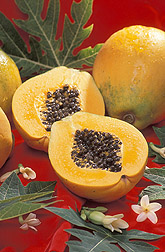This page has been archived and is being provided for reference purposes only. The page is no longer being updated, and therefore, links on the page may be invalid.
|
|
|
|
Papaya's Genome Unmasked by ARS Scientists, Colleagues
By Marcia WoodApril 23, 2008
Smooth, sweet papaya, one of America's most popular tropical fruits, has now surrendered some of its genetic secrets. Agricultural Research Service (ARS) scientists and others in a University of Hawaii-led venture have uncovered the structure or sequence of the genes and other genetic material that make up papaya's genome.
An article in the journal Nature reports details of their accomplishment, which represents the first time the genome of a genetically engineered crop has been sequenced. That's according to Dennis Gonsalves, director of the ARS U.S. Pacific Basin Agricultural Research Center at Hilo, Hawaii. He's also an author of the journal article.
"SunUp," the red-fleshed papaya chosen for the investigation, was developed in research that Gonsalves began in 1985. Working at that time for Cornell University's New York State Agricultural Experiment Station in Geneva, Gonsalves collaborated with scientists from ARS, the University of Hawaii-Manoa, and Michigan-based Pharmacia Company to create the new papaya.
The scientists genetically engineered SunUp plants to activate a gene—harmless to humans—that enables the papaya to resist attack by papaya ringspot virus. Starting in 1992, papaya ringspot disease, caused by the virus, threatened to destroy Hawaii's papaya plantations.
SunUp was used as a parent of a yellow-fleshed, virus-resistant papaya called "Rainbow." Made available to growers in 1998, Rainbow became Hawaii's leading commercial papaya.
Further scrutiny of the newly available SunUp genomic data is expected to speed identification of papaya genes that control prized traits such as flavor, texture, aroma, nutritional value, or resistance to insects and other pests.
Former ARS scientists Henrik H. Albert and Paul C. Moore are among the other authors of the Nature article. Maqsudul Alam of the University of Hawaii-Manoa led the genome exploration.
Papayas are rich in vitamins A and C and are a good source of potassium, an essential mineral.
ARS is the U.S. Department of Agriculture's chief scientific research agency.

